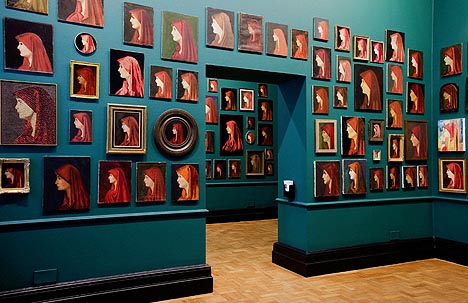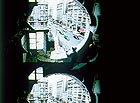
translated and summarized by: Liz Wollner-Grandville,
English summary August 24 - 31
National Portrait Gallery: Francis Alÿs – Fabiola
Lookalike phantom
Raphael’s “Sistine Madonna”, at the very least the detail of the slouching angel, or Leonardo’s “Last Supper”, even Dürer’s “Praying Hands” would have been a good bet. But the depiction of a saint nobody has ever seen or heard of before?
Nearly 15 years ago, Francis Alÿs started his collection - despite the meager financial resources available to artists. It was never meant to include works by artist-friends or paintings worth investing in, but rather a motif popular among amateurs, dilettantes, and dabblers, acquired at flea markets and antique shops.
It came as a huge surprise to the artist that not one of the renowned art historical works caught his attention, but rather the depiction of Saint Fabiola, in a version dating back to the 19th century, created by the French realist Jean-Jacques Henner. Alÿs collected 300 copies of this long forgotten work, which was disseminated as a reproduction of the original in Europe and the USA, 300 portraits of a woman, her head in profile with a crimson veil, 300 faces, which all resemble one another, yet each is different. A vigorous chin, a pudgy nose, the entire ensemble much like a cartoon. But what did the model really look like?
Fabiola lived in Rome during the 4th Century, was married twice, once to a brute from whom she was divorced and then to a man whose early death soon left her a widow. After her re-entry into the Christian community she cared for the poor and the sick, and was remembered as the patron saint of nurses. The English Cardinal Nicholas Wiseman wrote a bestseller about her life, which positioned the saint, who fit perfectly into the picture of a self-assured female protester including her Christian reversion, into the centre of attention.
After Francis Alÿs displayed his continuously growing collection, which is under the auspices of the Dia Art foundation in the Hispanic Society in New York, at the Los Angeles County Museum and now at the London National Portrait Gallery, the number of those who are convinced that they have discovered Jean-Jacques Henner’s original on their grandma’s attic and publicize their discovery on the Internet, is constantly getting larger. This would have surely not happened to the Belgian artist with Raphael, Leonardo, or Dürer. Was it possibly a stealthy patriotic gesture, a salutation to the Queen?
By Daniela Gregori
National Portrait Gallery
WC2H 0HE London, St. Martin’s Place, until 20.09.09
www.npg.org.uk
MAK: Artists in Focus #6: Franz Graf – Final Song First
On the drawing floor of the MAK
The way in which Franz Graf stages his works here is almost logical and nearly compulsory. The audience is confronted with the dynamics of the hanging. Some paintings seem to ascend or to have come to a halt right beneath the ceiling. Even the motives seem to have risen from the centre to the upper edge of the paintings. Or are they floating back down? Even the motion of slipping, of gliding away from the wall is implied. One of the pictures created in honeycombed minimalism seems to have come to a halt in an oblique position. Or was the intention to present it as if it was positioned on a stand? In any case, it is not at eye level. Lower edge at knee height. Upper border more or less at breast height. But it allows for the luxury of a comfortable aerial view by only tilting one’s had slightly.
Nevertheless: nothing has come apart at the seams. It becomes clear that Franz Graf succeeded to locate the inner film of an explosive dynamic of ideas at the exact right moment. To position the presentation and representation in a museums context as the main subject of attention he does not need art history’s wagging finger nor does he need to strike up ironic undertones. That is the main reason why only three large format paintings are conventionally hung on the wall. These works are owned by the MAK and have therefore been placed in a position, which befits an exhibition house.
All in all, Franz Graf’s typical black-gray-white exhibition correlates perfectly with Peter Noever’s exhibition space design and with that of presenting the collection of contemporary art on the attic of the MAK. The vertical steel poles running into the open space beneath initiate connotations with an essential part of a theater: the drawing floor. This enforces Franz Graf’s intentions of regarding the diverse presentation forms in art spaces. He interprets the space and points to the MAK collection in footnotes, by integrating some of Herman Czech’s chairs into the entire environment, which he designed for the MAK Café.
Franz Graf seems like the ideal artist for this space with its formative historic narratives, which match the artist’s interest in technically reproducible forms and link his reflections on ornaments as a kind of interface between applied and contemporary art at the MAK. His work, which goes beyond all limits, is also reflected in the title of his intervention “Final Song First.” As a supplement to the first, visual act of the contemporary art show collection he is planning a sound performance for the finalization.
By Roland Schöny
MAK-Applied Arts / Contemporary Art
1010 Vienna, Stubenring 5, until 20.09.09
www.mak.at
MAK: Georges Adéagbo – The Colonization and the History of the Colonized
Quest for Global Dominance
In La Fontaine’s fable “The Peacock complaining to Juno” the peacock bemoans that he has no talent to sing. Juno, the “Queen of Heaven” rebukes him. “No animal in everything can shine, by just partition of our gifts divine.” And: “if there is any discontent, I’ve heard not of it.”
Georges Adéagbo’s installation of La Fontaine’s simile - a commissioned artist from Benin painted this text with an illustration – comes across as rather cynical, as this exhibition deals with the topic of colonization. The artist collects different types of material on the walls and the floor as well as the niches of the MAK gallery: newspaper clippings, postcards, records, travel guides, novels, travel reports, flyers on upcoming art events, and paintings with descriptive texts about the monarchy.
Austria’s kitschy monarchal image forms the main theme of Adéagbo’s multifaceted and carefully composed assemblage: a card, on which Vienna markets itself as the “City of Music”, another with a e Gugelhupf (Bundt cake) recipe, Sisi-pictures everywhere, an advertisement for the champagne brand “Metternich”, dancing couples dressed in their national costume depicted on records, and a nature glorifying newspaper ad for a food company.
Adéagbo links these elements with African figures, which were carved by Benin artists, newspaper clippings on world politics, books including the Handbook of applied Ethnology” published in 1947 “Africa, which pleas for colonization, war reports or novels on “important discoverers”.
Adéagbo’s work is considerable. Although the juxtaposition of nationalistic tendencies and the quest for global dominance, two categories that are prerequisites for one another, are presented convincingly, less would have been more: the abundance of material results in inaccuracy, which is not at all helpful. The interventions in the permanent collection of MAK are unmotivated rather than well conceived.
By Nina Schedlmayer
MAK Applied Arts /Contemporary Art
1010 Vienna, Stubenring 5, until 13.09.09
www.mak.at
Generali Foundation: Modernism as a Ruin – Archaeology of the Present
Deteriorating unglamorously
The current exhibition at the Generali Foundation proves that Modernism should be anything but given short measure. On the one hand, the project “Modernism as a Ruin” deals masterfully with artistic media, and on the other it focuses concisely and in a fascinating way on its main theme. Sabine Folie, the curator and director of the Generali Foundation, juxtaposes historic positions, primarily those of the 70s with later ones, some of which are real discoveries.
The starting point – the promise of modern design in the broadest sense – might be well known. But its mutation, decay and unglamorous deterioration is consequently and enlighteningly uncovered by these works; oftentimes the periphery moves into the centre of attention: Gordon Matta-Clark’s expeditions through sewage systems, his exploration of the New York wastelands including the garbage incineration and the construction of a garbage wall or Robert Smithson’s slide show “Hotel Palenque” in which a crumbling building and its surroundings are archeologically dissected, are considered as classic Modernism-criticism; they are supplemented by the fine etchings and linoleum prints – these technologies still exist! – by Rob Voerman, who lets facades superimpose and mounts city landscapes in seemingly extra-terrestrial settings, by Cyprien Gaillard’s video “Desniansky Rayon”, in which the spectacular blowing-up of a deteriorating apartment block in Paris is shown or the threateningly pointed mirror sculptures by Giuseppe Gabellone, in which the context and the bodies seem dismembered.
Many of these works are linked by the loving and careful way in which the topic of destruction is dealt wih. And even if one only watches excerpts of the films and videos, the purpose of this show is recognizable. Repeated visits are nevertheless advisable.
By Nina Schedlmayer
Generali Foundation
1040 Vienna, Wiedner Hauptstr. 15, until 20.09.09
foundation.generali.at
Mehr Texte von translated and summarized by: Liz Wollner-Grandville


 Teilen
Teilen



